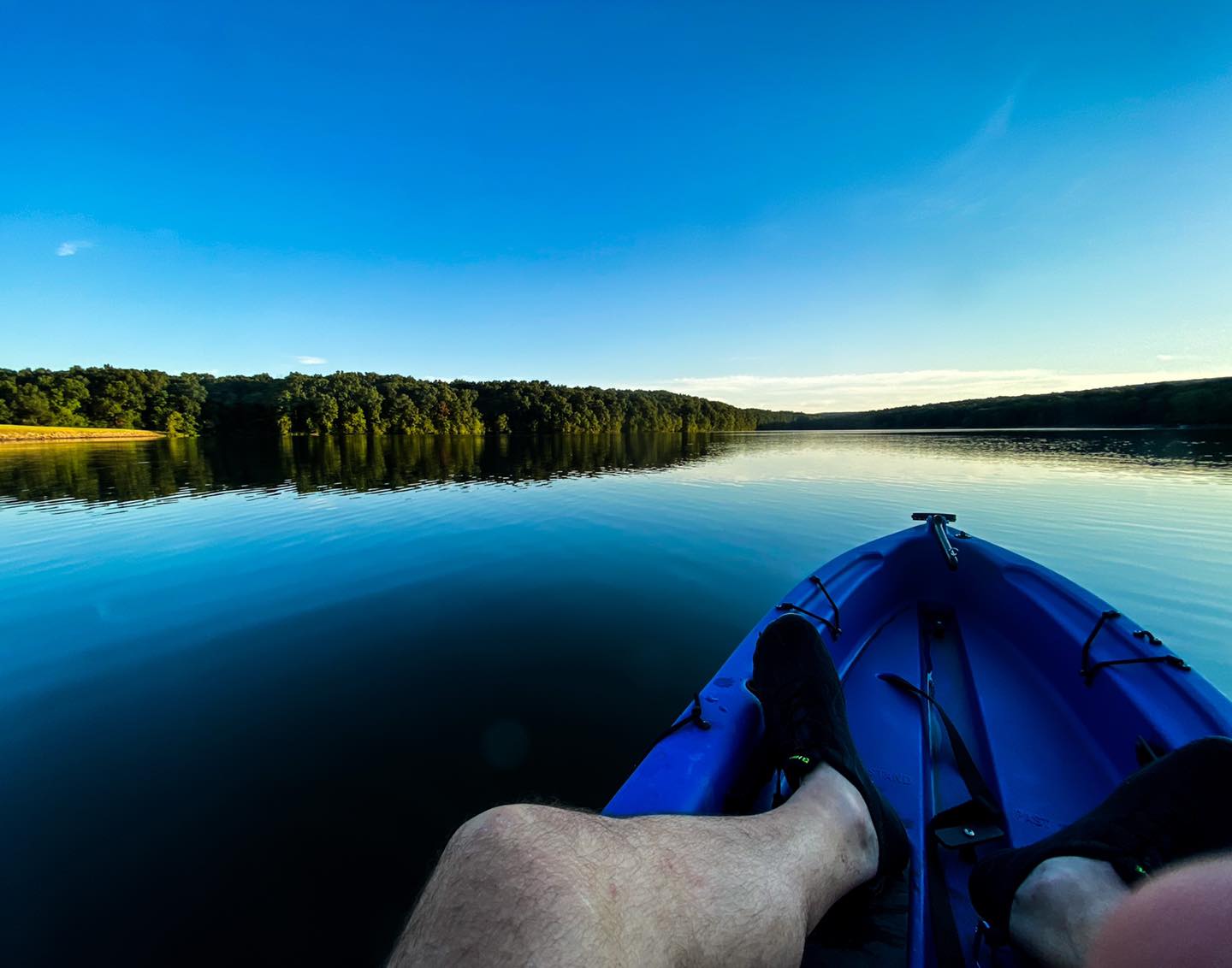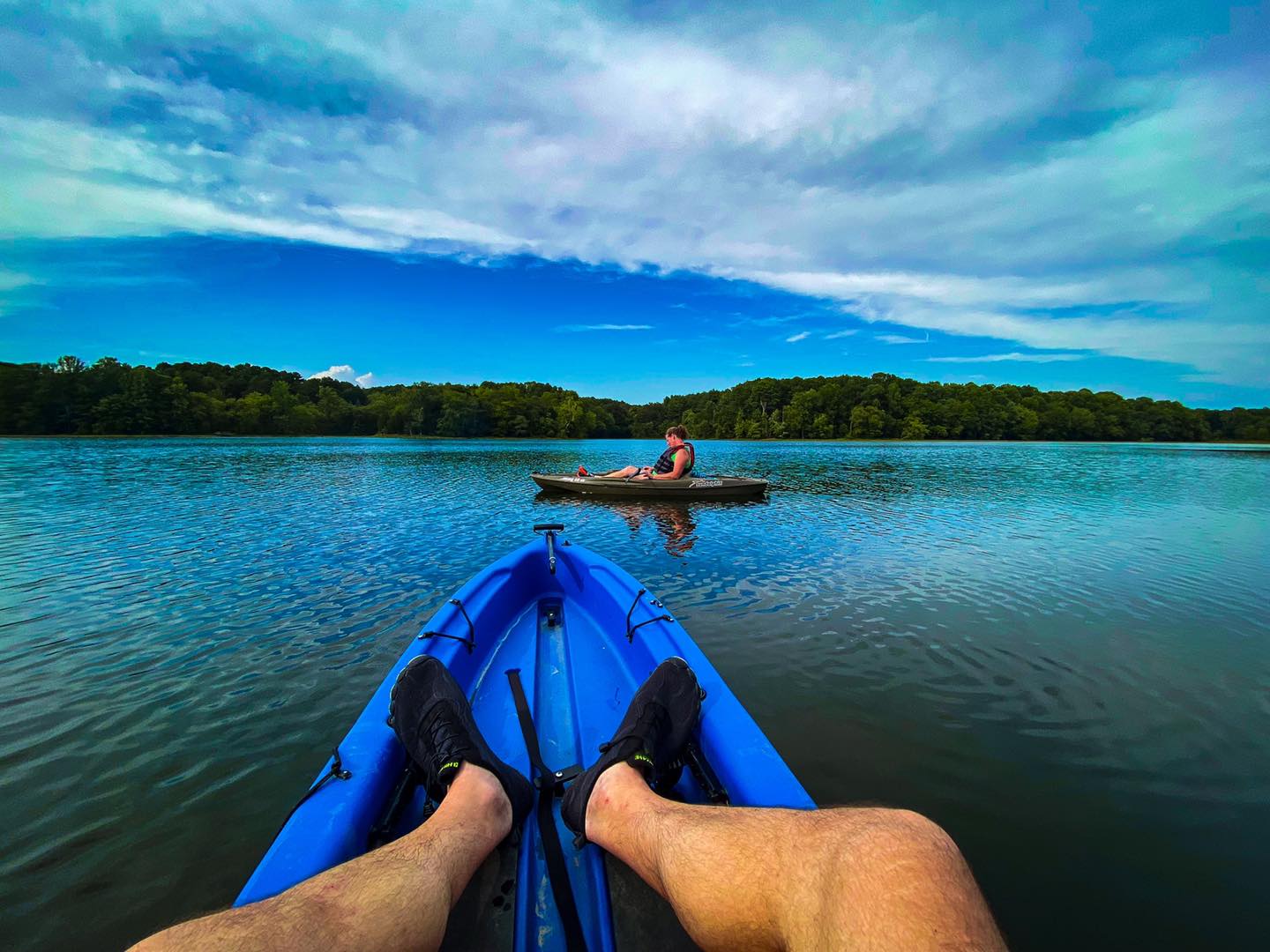Kayaking for Beginners: A Guide to Start Kayaking Today
Welcome to the kayaking for beginners guide!
I wanted to write this guide to help you try kayaking and fall in love with it if it’s right for you.
Storytime – Up until last year, I was terrified of kayaking. I never tried it because of my fear. I was scared of it because I’m not the best swimmer. I finally tried it last year and immediately fell in love with it. I feel completely confident while kayaking today. If fear stops you from doing it – take it from me; it’s a blast and not that scary if you do it right.
In this kayaking for beginners guide, I’ll try to cover everything to get you started with enjoying a kayaking adventure.
Jump to a section in this article:
Kayaking for Beginners: A Disclaimer and Reminder of Safety
First thing first, folks – Kayaking can be a hazardous activity. If you fall into the water and cannot swim, you could drown as a result.
You must wear the proper Personal Protective Equipment when enjoying a kayaking adventure. Make sure you put safety first, and always tell someone where you’re going before you go kayaking.
The purpose of this article is for education and entertainment only. Kayaking is at your own risk and decision.
Why Try Out Kayaking?
There are many benefits to kayaking and why you might want to try it out.
For starters, kayaking is healthy. It works your upper body out. Your arms gain strength as well as your core as you’re using it to control the direction of how your kayak moves. The more you kayak, the stronger you will get.
As a hiker and a cyclist who just works out my lower body for the most part, kayaking has been a great way for me to balance my fitness out more.
Kayaking is also good for your mind and mental health. It allows you to use logical thinking to keep yourself afloat and safe. It allows you to disconnect with technology and the grind and focus on nature which is good for your mind, body, and soul.
In many cases, kayaking allows you to visit areas that you normally wouldn’t be able to visit without a kayak. There are all kinds of those areas where I’m from around the Shawnee National Forest.
My kayak allows me to get to everything.
Kayaking for beginners is a great thing, too, because it’s easy to get the hang of. You’ll become a professional at it in no time as long as you’re willing to learn from your experience.
And lastly, kayaking is an adventure, and it’s fun. That alone makes you want to try it yourself, doesn’t it? Who can pass up a fun adventure?
Before and After You Buy a Kayak
There are some important things to know and do before you go out and buy a kayak.
There are many different types of kayaks. The two common ones are sit-in kayaks and sit-on-top kayaks. Sit-in is where you’re inside the kayak in a depression. Sit-on-top is when you sit directory on the kayak without an inner cockpit. Larger-framed people typically enjoy sit-on-top kayaks more because they’re easier to get on.
I am 6’5″ tall. I have a 14-foot sit-on-top kayak to account for my height and weight. It fits me perfectly. I find sit-in kayaks to be uncomfortable to get in and out of. Sit-on-top kayaks are also typically recommended for new kayakers.
But you should try both types to see which would be best for you.
There are many other types of kayaks to choose from. Some include touring, inflatable, tandem, and whitewater kayaks.
The best way to kayak and decide which type of kayak you want to use is to use someone else’s kayak first. This will also give you an idea of whether kayaking is even your thing.
If any kayaking rental companies are in your area, rent one from them and try it out. This will typically allow you to try both sit-in and sit-on-top kayaks to determine which would be best for you.
It’s best to hire a guide or kayak with a tour group if you have no one else to go with you. You should never kayak alone for the first time. Consider signing up for a kayaking class if it’s offered in your area. They can teach you important lessons like how to roll a kayak if you have capsized. If there are kayaking clubs in your area, consider joining one.
If there isn’t a rental service, try to borrow one from a friend if you can. A kayaking club might be able to let you use one of theirs to see if you like it.
If you’re ready to buy a kayak, you can practically get them everywhere. They tend to hold their value but can be a litter cheaper when you buy them used. Make sure you inspect the kayak well before making your purchase. You can buy them new from most sporting goods stores.
Kayaking for Beginners: Gear
Like with any form of outdoor recreation, it’s important to have the right gear. Here is some basic kayaking for beginners gear items to consider when you want to start kayaking.
- Personal Flotation Device (Life Jacket) that fits you
- Paddle for your kayak
- Bilge Pump (to help get water out of your kayak in an emergency)
- Spray skirt (to keep water out of your cockpit)
- Seat
- Kayaking bag (many seats come with connected bag options)
- Plenty of water (stay hydrated)
- Plenty of snacks (stay fueled)
- Sun protection (sunscreen, lip balm, and sunglasses)
- First Aid Kit
- Whistle (for distress signaling)
- Rope (for towing or emergencies)
- Headlamp (and maybe even a stronger flashlight for emergency signaling)
- Dry bags (to keep everything dry)
- River Knife
- Duct tape (it will fix anything!)
- Personal Locator Beacon (just in case!)
You might find other types of gear necessary the more you kayak.
Personally, I also equip my kayak with multiple mounts to add my GoPro to so that I can film my floating adventures for my YouTube Channel, which you should subscribe to if you haven’t already.
Clothing Ideas for Kayaking
There are many different types of clothing you could wear for kayaking.
The most important way to decide what to wear is to know what the conditions will be like, such as the weather and temperature. Dress for the conditions before anything else.
You can wear regular hiking clothes if you want to. You can wear shorts and summer clothing but do keep the sun in mind. If you burn easily, make sure to use an appropriate amount of sunscreen and lip balm. You might also consider a fishing hat or something like that to help keep the sun off of you.
You can wear a swimsuit, swim jammers (which are like bike shorts) or swim leggings. You could also wear a spring suit (warm weather wetsuit) if you wanted that additional buoyancy.
For colder kayaking trips, you may require a wetsuit or a dry suit which is thicker neoprene meant to keep you dry and warmer if you happen to get into the water.
You could wear your regular hiking apparel but try to use layers to keep yourself warm while being able to cool down if needed.
Wearing water shoes, sandals, or Crocs when kayaking is best. In the colder seasons, neoprene socks may be a good addition to keep your feet warm.
Take some rain gear with you just in case you might need it.
Don’t wear cotton or denim when deciding what to wear, as it will hold in moisture and make you uncomfortable during your kayaking adventure. Stick to wicking synthetics such as polyester, Lycra/spandex, nylon, and wool.
Kayaking for Beginners: Tips
These tips are meant to help with kayaking for beginners. You’ll learn more ways of doing things easier the more experience you get while kayaking.
Kayaking Fit
It’s always a good idea to try different kayaks before you make a buying decision. Sometimes your size isn’t compatible with certain types of kayaks. For example, I would be uncomfortable in a sit-in kayak because of my height. If you can try before you buy, take advantage of that luxury.
When adjusting your foot pegs, your butt should be snugged firmly against the back of your seat. You should be in an upright position. Your feet should firmly be against the foot pegs. Your knees should be slightly bent, and you should be able to firmly touch both sides of the kayak with your legs.
Most kayaks have adjustable foot pegs or peg links that you can choose to get the right one for you and your fit.
A proper fit will help to ensure you have a comfortable and pain-free time. It also helps prevent your kayak from capsizing because you have firmer control of the movement of your kayak.
Launching Tips
The best place to launch is at a shallow water area such as a bank, shore, or even a beach.
If on a moving body of water, such as a stream, creek, or river, keep your kayak partially on land as you enter it.
Ensure your paddles are secured and cannot escape you while trying to launch.
Stand over your kayak, straddling your seat or cockpit. Grip your hands on the kayak’s sides at the seat or the sides of the cockpit. Sit your butt down on the seat and then bring your legs in.
Scoot your butt against the back of the seat and your feet against the foot-pegs.
Use your paddle to move your kayak into deeper water or to get you off the bank. You might have to move your body forward (in a jerking motion) to help your kayak get into the water.
If you have a spray skirt, attach it in calmer waters away from big waves and wake.
To bank and get out of your kayak, you’ll simply reverse these steps but do try to get some speed up as you make your way to bank your kayak.
Paddling Tips
Make sure you use the right type of paddle for your kayak.
Most paddles are broken down into two. When attaching them together, make sure the clasping mechanism is locked, and the paddles are secured to one another.
The paddle blades should be in line with one another.
If you can safely do so, paddle around the area, you launched in to try to get the hang of how it works. If you want to go left, you’ll paddle to the right. If you want to go right, you’ll paddle to the left. To slow yourself down or stop your kayak, put your paddle in the way and firmly hold it to drag the kayak to a slower speed or a stop.
To get going, paddle from one side to the other. Sometimes you’ll have to paddle on one side a few times before switching to the other side to go in a specific direction you wish to go in.
There are four basic types of paddling for kayaking. Those include forward paddle, reverse, sweep, and draw. It’s good to get used to being able to paddle with these techniques.
Kayaking for Beginners: Safety
Your safety should be a priority, meaning you will not perform unsafe acts, and you’ll understand the associated risk that you take when kayaking.
Drowning is real. Many people die from drowning every year. Some fatalities are experienced swimmers and kayakers. Accidents can happen, so always being alert and vigilant is important.
Always wear a Personal Flotation Device (life vest/life jacket) that fits you properly. Those who drown typically are not wearing any type of FFD, including experts in swimming and kayaking. Your PFD may save your life one day.
Try not to kayak alone. Go with a friend or join a kayaking club with multiple kayakers.
Always tell someone where you are going before you go, just in case you don’t return.
You need to know and understand your limits. If you try to push yourself harder than you’re able to go, you could get hurt or worse.
Try to research the area and kayaking reviews before you go somewhere. Those reviews might help you decide what gear to bring and if it is even a good idea to go in the first place. There might be a lot of debris in the water that could make you easily capsize, and reviews are good for informing you of those types of conditions.
Check the weather and the water temperature before you go. This will help you determine what to wear. Watch for unexpected changes in weather and conditions when out on the water.
Bring a whistle and a bright signaling flashlight if you need emergency assistance or become lost after dark.
Stay hydrated and fueled while you kayak. It doesn’t take long to dehydrate after being in the sun all day.
Avoid using alcohol, a medication that causes drowsiness, or drugs while kayaking.
Only kayak in areas that you’re allowed to kayak in. Never trespass or knowingly violate the law.
First-Time Kayaking Tips
Here are some great first-time tips for kayaking for beginners to help you further enjoy your adventure.
For your first time kayaking, consider choosing a calm body of water such as a lake. The best kind of lake is one with restricted motor horsepower or a “no wake” type lake. This will give you an easy kayaking experience to better learn the basics.
Try to find the easiest launch point you can. This will be a shallow area with a gradual drop, such as the banks of a river or a beach on a lake. This will make launching and returning to dry land easier after kayaking.
Choose to go kayaking on a nice day without rain and wind for your first time. But be prepared for changing weather conditions, just in case.
Take your time and learn from your own experience.
If the initial shaking of your kayak intimidates you, sit still, breathe regularly, and let your kayak become steady. You’ll eventually shake it from side to side with ease, knowing you have control over your kayak. It gets way easier and less intimidating, I promise.
Your first time kayaking can be a short trip. You can spend a half hour or less in the water. The first time is just an introduction. Go farther and longer when you feel comfortable doing it.
While turning your kayak over or capsizing is very much possible, it’s difficult to do it unless you disregard safety and common sense.
And that completes this guide for kayaking for beginners. Now that you’ve learned a few basic tips, it’s time for you to get out there and get some experience. Who knows! You might eventually be doing overnight kayaking camping trips. I know I’m excited about doing some myself. If you’ve enjoyed this article and want to support me in writing it, please share it with others and consider leaving me a small donation if you want to. Join my free monthly newsletter for more kayaking tips and resources sent to your inbox.
Please Support Hiking with Shawn
Alrighty folks, I hope you have enjoyed this content. I provide it for free and it takes a while to create. If you would be so kind enough to support my efforts, you can do so by sharing this post with others, especially on social media. Be sure to subscribe to my YouTube Channel to see my latest videos, shorts and live streams. Follow me on Facebook, Instagram, Twitter and TikTok for unique content that you will only find on those pages. You might also join my Southern Illinois Hiking & Outdoor Resources Group on Facebook, too!
You can also support me by becoming a Patreon Supporter for as little as $3/month and you can cancel anytime (no contracts or catches). Patreons get access to extra features, exclusive articles, sticker packs, gifts and more. Consider buying official Hiking with Shawn Merchandise as another way to support me. I spend a lot of money on Hiking with Shawn and because of extremely high public land permit fees, I make very little money in return so everything helps.
Thanks again for checking out another one of my articles and until next time, I’ll see you on the trail!

Shawn Gossman
Founder, Hiking with Shawn
Howdy folks! My name is Shawn Gossman and I founded Hiking with Shawn. I’m an avid hiker, cyclist and outdoorsman here in the Shawnee National Forest. I was born and raised in Southern Illinois and never want to leave. Click here to learn more about Shawn Gossman



